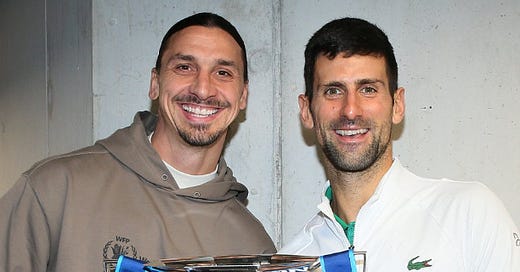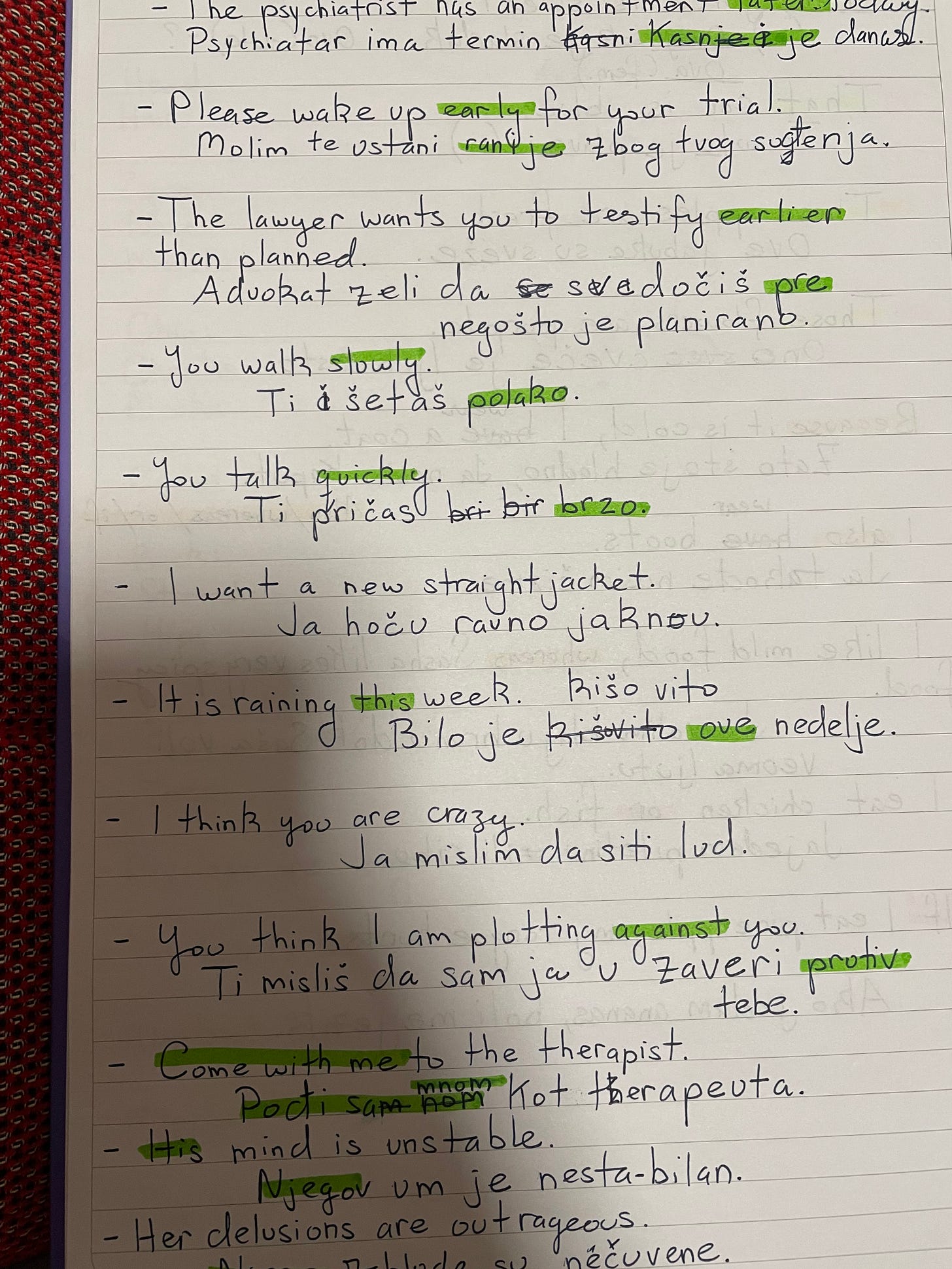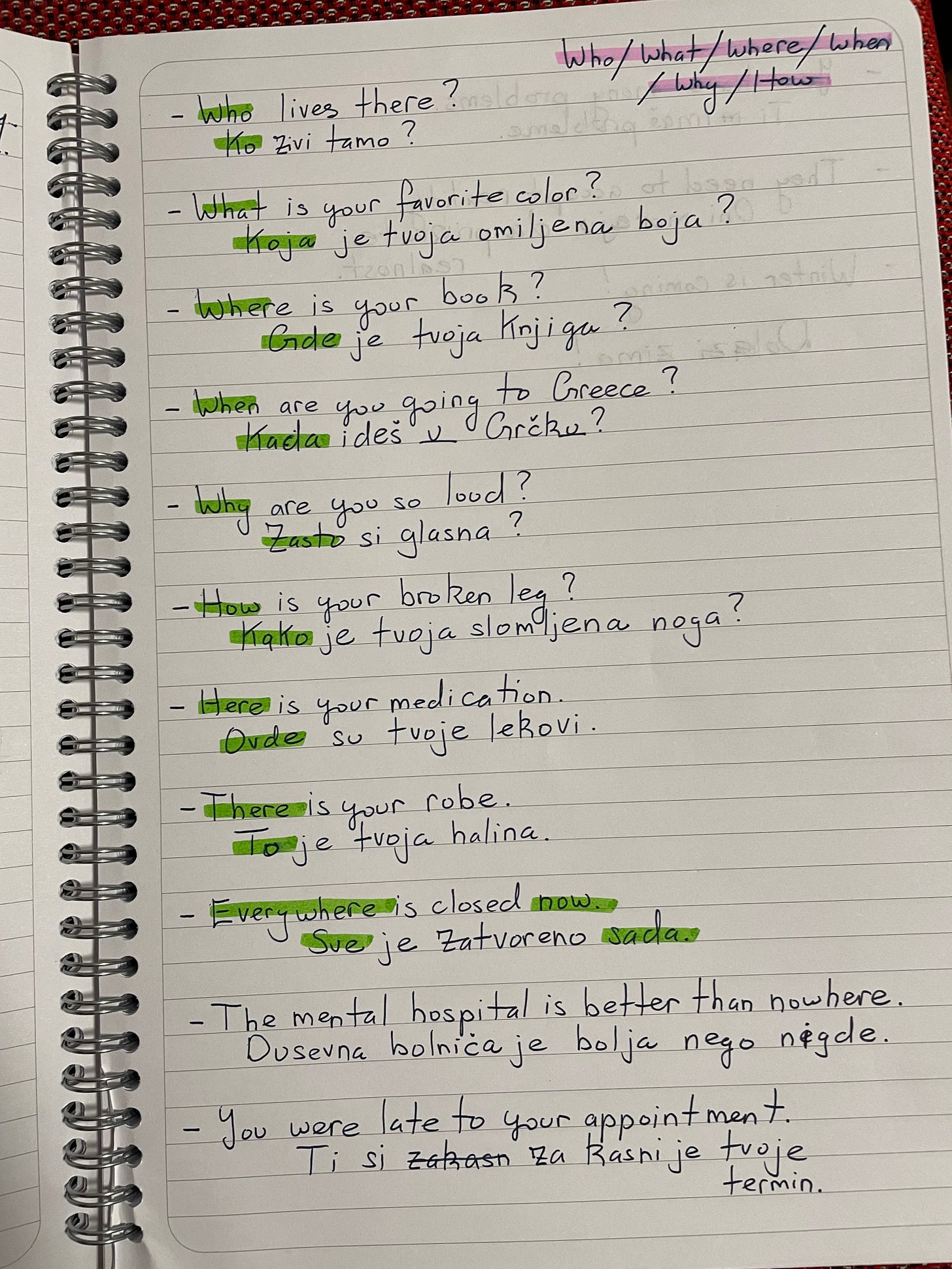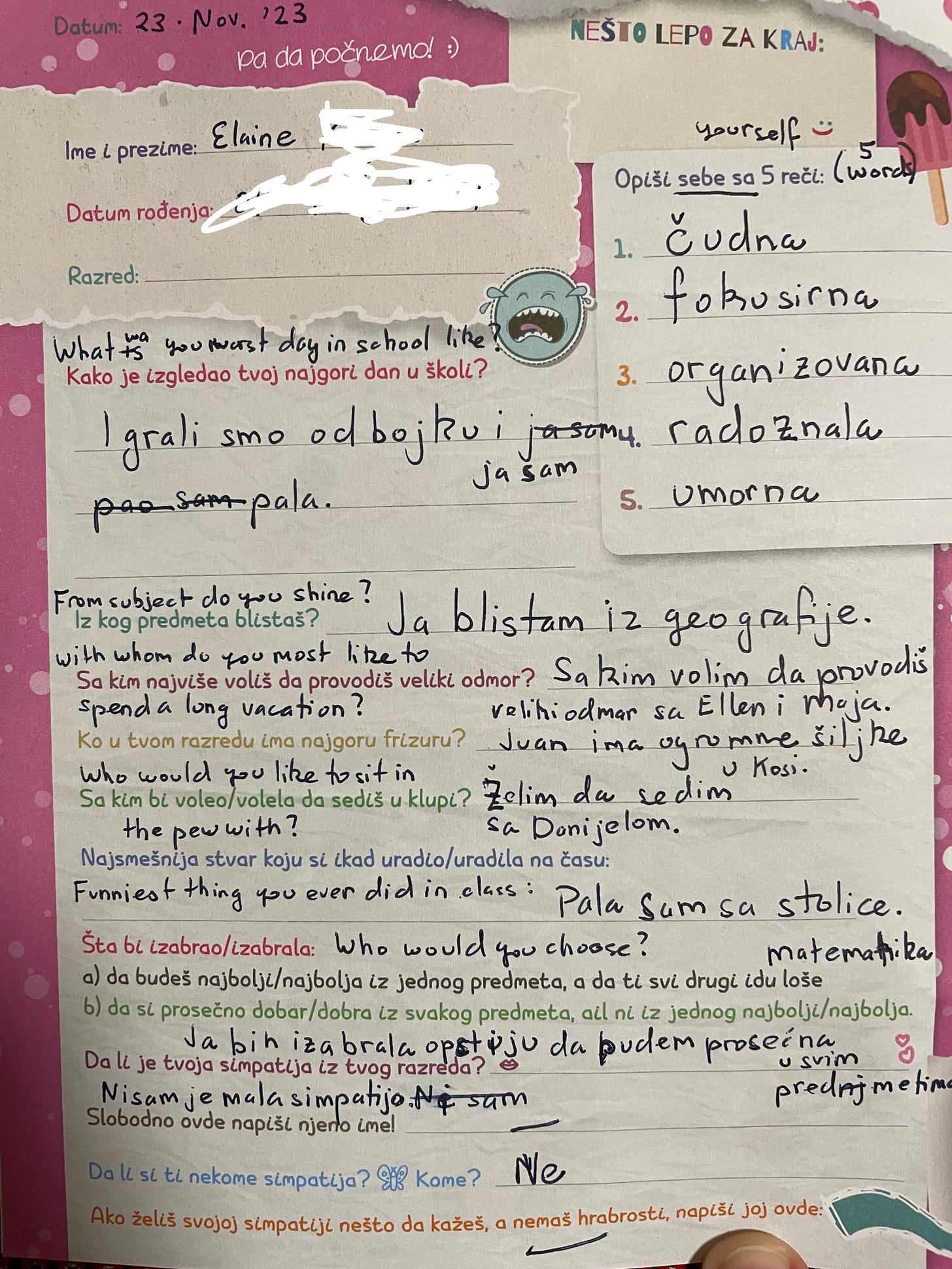My Twisted Tongue: Adventures in the Serbo-Croatian Language
On learning a South Slavic language
What
Uses 7 declension cases?
Goes by 6 names?
Is spoken in 5 countries?
Has 4 verb tenses?
Employs 3 genders (NOT as in gender identify :/), but as in masculine, feminine, and neutral noun categories?
Is written in 2 alphabets?
Has 1 particular person feeling like she’s taking crazy pills?





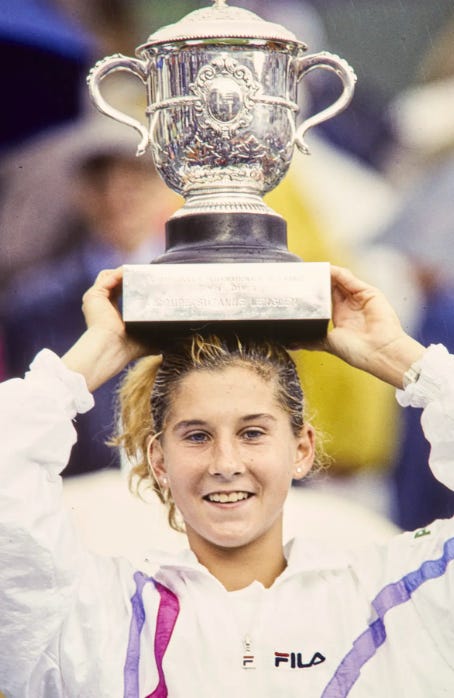
I am the crazy pills taker here, an adult learning a whole new language. That language is *Serbian, formally known as “*Serbo-Croatian,” and formerly known as “*Yugoslavian.” It’s also referred to as *Croatian, *Bosnian, and *Montenegrin. Here in Serbia, it is written in both the Latin (Latinica) and Cyrillic (Ćirilica) alphabets, making it the only language in Europe requiring knowledge in two scripts for academic fluency. It is the language I am currently trying to learn.
Some samples from my Serbian scrawl, only Latinica at this point in time
The Language
Serbo-Croatian is spoken by around 17 million native speakers worldwide. Nikola Tesla, Mihailo Pupin, Mileva Maric-Einstein, and Ivo Andric spoke it. So did Karl Malden, Peter Boganovich, and Rose Ann Vuich. Another native speaker, Zlatan Ibrahimovic, favors it for on-pitch outbursts, because he considers it, along with Italian, a good language for trash talk in the heat of a match.
Nikola Tesla, the “man who invented the 20th century,” a speaker of Serbo-Croatian
Before becoming the first female state senator in California, Rose Ann Vuich spoke Serbian at home with her parents, farmers who settled in the Central Valley
If you miss a ball, Zlatan might blast you with 7 different declension cases (nominative, genitive, dative, accusative, locative, instrumental, and vocative…not that you asked!)
Sasha grew up speaking it in Southern California, where he used it during AYSO games to communicate with zemljaci (countrymen) teammates and befuddle opponents. And he did so donning his Red Star Belgrade kit, because the AYSO was child’s play and he amped up his training during summer trips to Yugoslavia.
Sasha’s soccer skills and Ćirilica signature
South Slavic Formalities
I’m just going to call the language “Serbian” here since I am in Serbia, which is the largest nation, in terms of population, where this tongue talks. Serbian is a member of the South Slavic (Western sub-group) branch of the Slavic language family, a sibling of Slovenian and a cousin of Macedonian, and Bulgarian.
Serbo-Croatian on the Slavic language family tree
Spoken Serbian dates back millennia, but its first dictionary and codified set of grammar was published by a linguist by the name of Vuk Karadžić (1878-1864). Vuk, whose name means wolf, was a cub born into a region howling with poverty and political violence. His parents’ only surviving child, he lucked out having one literate cousin who taught him to read and write. Like many of his generation, he crossed the Sava into Austrian-controlled territory, picked up German, worked as a scribe, language teacher, and clerk, plus made connections with political movers and fellow linguists.
Painted portrait of young Vuk Karadžić
When the first uprising against Ottoman rule petered out, he made his way to Vienna before making his way back to Belgrade, publishing collections of folk songs and poems, as well as a textbook of Serbian philology that highlighted the language’s grammatical structures. He believed that the language needed to be written as it was spoken, so in the course of his academic works, he sought to simplify the language structures to make it maximally accessible as a written language for a people working towards universal primary education. By the end of the 19th century, literacy rates rose as Serbia became independent, and the Austrian-style system of schooling spread from Vojvodina southwards as new generations became literate in the language reformed and codified by Karadžić.
Vuk Karadžić monument in the city of Loznica, near his birth village of Tršić
Almost two centuries later, I am working towards speaking, reading, and writing in Serbian. Since there are no software programs like Rosetta Stone, I waited until we arrived to start working on the language. I clobbered together what web-based resources were available, bought some notebooks, found a children’s workbook, and hired a private instructor. I work with the instructor weekly, and carve out practice time by myself and with Sasha. I speak in stores, greet others, and try to follow rapid (brzo) speech while staring like a deer (jelen) in headlights. The declensions throw me for a loop, and while some of the vocabulary comes smoothly, certain vowel-lite words truly twist my tongue. As in, I have actually bitten my tongue trying to properly string together consonants in words like tvrđava (fort or fortress) because four consonants in a row tests my language limits.
There must be some linguistic magic in the local water, because the knack for mastering multiple extremely complex languages is strong in this region. When I go to the ATM, it gives me the options of Serbian, English, German, or Hungarian. I accidentally hit the Hungarian option once, and thought I was having a psychotic episode. The fact that many people in Northern Serbia speak both Serbian and Hungarian fluently makes me feel like I cannot even call myself literate. I don't expect to become fluent, but I will do my best to function in Serbian.
Children’s workbook in Serbian asks young ones to describe their worst day of school, as well as identify the classmate with the worst haircut
Fun Findings
Despite my frustrations, every new word brings some sense of achievement, and as an etymology enthusiast, morpheme associations and origins from other languages always stand out. Here are some fun ones so far:
Čizme is the plural for boots. One boot is a čizma, and two boots are Čizme. In Spanish slang, chisme, which sounds similar, means gossip. When I mentioned this to my language teacher, she was responded with “As in Gossip Girl?” Yup! Blair and Serena wore Čizme and they spouted even more chisme!
A šargarepa is a carrot. Sasha thought it was Turkish in origin, but not quite. It is actually Uzbek, which is a Turkic language, and since carrots, like apples, originated in Central Asia, the word made its way into the Balkans and is still used in Serbian to designate that orange root vegetable rich in beta carotene.
Peanuts are called kiki riki in Serbian, and there is a satirical pop song featuring the crunchy, salty legumes. You can listen here. The song was the brainchild of the Yugoslav pop group Rokeri S Moravu. Known for their parodies, they were the local equivalent of Weird Al Yankovic, who himself is half Serbian.
Znam, or Ja znam simply means, “I know.” It’s not funny in and of itself, but what makes it funny to me is that when Sasha speaks Serbian to family members, he says it every few minutes, like clockwork. Years back, I asked him what “Znam” meant, and he told me it meant “Sasha is king.” I looked it up and called his joke, but every time I hear him say it, I remember his imaginative response.
Another amusement involves GPS, and the American robo-voice from my iPhone. On our way to a birthday celebration, it told us to turn right on “Anti-Fa-sis-tit-kay Bor-bee.” It totally butchers street names, which I find comforting because if AI sounds worse than I do, there is hope for my pronunciation. And yes, the name of the street, in English, translates as “Anti-Fascist Battle,” no street for surrender!
Sometimes life has you turn right on Oak St, or left on Maple Dr, but it directed us to take Anti-Fascist Battle all the way to the river’s edge to where the swan’s swim on the Sava splav (waterfront)
Meanwhile, I am going to get back to twisting my tongue around this intricate language!

